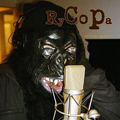Uncle Green: Lost and Found
 The legend of the “great lost album” is one of the most enduring in rock ‘n’ roll.
The legend of the “great lost album” is one of the most enduring in rock ‘n’ roll.
In the case of Uncle Green, fondly remembered from their major-label days in the early-to-mid ’90s, the legend is actually true. And the evidence — sometimes scarce with legends — can be found today at your favorite music retailer. It is called Rycopa.
Uncle Green — Matt Brown, Jeff Jensen, Bill Decker, and Peter McDade — wrote and recorded Rycopa in a shared house in Atlanta in 1997. The sprawling, 32-track album then promptly disappeared into the vaults of Sony Music, locked away for what might easily have become forever. How it resurfaced 14 years later is a revealing story about how artists and their art change over time.
And it rocks, uh-huh. Check it out now before it disappears again.
Buy at Amazon | CD Baby | iTunes
[soundcloud url=”https://api.soundcloud.com/tracks/101717136″ params=”color=ff5500&auto_play=false&hide_related=false&show_comments=true&show_user=true&show_reposts=false” width=”100%” height=”166″ iframe=”true” /]
Wampus talks with Uncle Green about ‘Rycopa’
How did you come to record Rycopa in your house rather than a commercial studio? Was that the band’s idea or Sony’s?
It was our idea, though I don’t remember which one of us dared to say it out loud first. It had always been a dream of ours to make a record in a house, fueled by images of the Stones holed up in some old mansion as they made Exile. Maybe we knew, instinctively, that this was our one chance to pull anything like that dream off.
For us, Sony was the Distant Overlord that cut the checks for 57 Records, run by our producer/friend Brendan O’Brien, so we didn’t always need to clear things through them. I’m not sure what plans, if any, the Overlords had for our second Sony record; I always imagined we only even got a second crack because of Brendan. The budget was still small, too. Brendan had a mobile board, we rented a small house, hired just one engineer, and somehow milked two months out of less than 100 grand.
What were your ambitions for Rycopa during its creation? Commercial? Artistic? Both?
Both is the only answer, though we must have known while we were in the thick of it that songs like “Claire & Allison” and “Sunrise Lullaby” were no one’s idea of commercial. We wanted to have a much different experience than Vulture (released after the band changed its name to 3 Lb. Thrill -Ed.) — not because we were unhappy with how that record came out, but because different was always more interesting and challenging. Much of Vulture had been tracked live, a reflection of the songs, as well as a reflection of the way we managed to get time to record, here and there, as we looked for a new deal. Once we signed with 57 Records we finished the record the way it had been started, with the band all playing at once on most basic tracks.
The artistic goal for Rycopa, then, was to go about things in a new way. We went into the studio with no preconceived notions. Every day started with Matt or Jeff playing us a new song to work on. Then, for each track, the recording approach varied, often by trial-and-error, sometimes with first take magic or luck, and most were built a layer at a time, with a drum loop or track followed by whatever someone wanted to try next. Examples: The first song we tracked was “Pretty Good Lie,” and Matt knew he wanted a drum loop as the base. We started with a regular kit, and then, as if just realizing how we could reinvent our approach, put the bass drum on its side, so I could play it with mallets. The loop has a very flowing kind of feel to it, as a result. For “Super Kitty” I just played to a click while Jeff hummed the melody as a guide, because those echo-y guitars were very hard to lock into. On “Sunrise Lullaby,” Matt played one of the keyboard parts first, I think, and then I played a snare drum part to a slowed-down track, so that it would sound all tight and military when sped up to normal speed.
Anyone with an idea was welcome to try it, even if the rest of us suspected it wasn’t going to work. Horns? Bring it on. Strings? Luckily we knew a great player. We even looked for a bag-pipe player, which turned out to be the one pipe dream we couldn’t muster. By the end, each song had its own recording story, which is what we’d intended.
Sony “didn’t hear a single” on the album. Did you think Rycopa had commercial potential when you submitted it? Had Sony specifically asked for a commercial record?
I don’t think they had to ask for it to be commercial — after a previous spin on a major we knew that numbers were numbers, and that the numbers for Vulture were not enough to keep spending Sony’s dough. At the same time, I don’t remember feeling the need to sit around and craft a “hit.” Call it naiveté or stubbornness or stupidity, but after being a band for as many years as we had been already, what we wanted most was to make the record we wanted to make.
That said, when it was done I truly believed it would come out. Not as 32 songs, of course — after a disappointing first record, who would support the move to a double CD? Picking just 14 songs, say, never mind 12, was a challenge for all of us, but when you looked at those sample track lists it also seemed to me to very much be a commercial record. A very different record than Vulture, indeed, but certainly with plenty of songs that could be heard on the radio. Somewhere. Some universe. Maybe? Even now, I think “Redneck World,” “Pretty Good Lie,” and “Not in Range” are just some of the possible singles. But certainly most of the songs were not guitar-driven, one-listen sledgehammers, which is what everyone in the business seemed to want at the time.
What happened after Sony passed on the album? Did you plan to release a modified version of Rycopa, or was it banished to Siberia without discussion?
Not banished at all. Brendan said we could have the recordings, and we went out and about looking for a new deal. An A&R guy from MCA came down to work with us on arrangements and recording approaches, and I think rough numbers were even being talked about with our manager when MCA was bought — maybe by Seagrams? In any case, our A&R dude lost his job, our planned new recording sessions at Brownsville were erased, and it seemed hard for any of us except Matt to work up the energy to go forward. There were also a few ideas about putting it out on one of the bigger indie labels, but it seemed to drag on and on and eventually we were just dispirited.
Even when we were planning to record new songs, and new versions of some Rycopa stuff, I think there were at least a few tracks we planned on keeping. After the deal with MCA fell through, Matt went off to make a solo record, the rest of us moved on, and we all managed to forget to grab the reel-to-reels. I’d love to go back in time and grab the tapes on our way out the door of 57 Records, before that label folded and our masters wound up in the vast Sony archives.
Last question, two parts: While you were making Rycopa, what did you think it was about? And what do you think it’s about now?
My first instinct is to say the meaning is, at its core, the same: Rycopa was the best single encapsulation of our band — “Uncle 3 Lb Green Thrill” — that we’d created. The humor, the darkness, and all the musical mood swings, captured over an intense two-month period. At the time, I thought it was the best record we’d made, and that feeling has only gotten stronger. It felt true to us at the time, and listening to it today, it still sounds like who we were — as a band, but also as people and friends.
While we were making it, I suppose I also thought it was a sign of the new direction(s) we’d be taking. People were getting married, kids were in the not-too-distant future, and we were all in our 30s. It was exciting to think of what would happen next, and I enjoyed the way the record hearkened back to more of the kind of Uncle Green pop we’d made years ago, while still having the sort of world-weary edge of 3 Lb. Thrill. Ironic, now, to think of how optimistic I found the process and product.
And now? Now I find it satisfying, just as satisfying if for very different reasons. We’d tried, and failed, to find the tapes many times, so even tracking them down was an accomplishment. And I’ll never forget sitting in the studio with Rob Gal, the engineer who helped us mix all of this stuff, putting up the first reel. After so many years, we didn’t even know if the reels would still play. And then “Dymaxion” came out, loud and alive as ever.
So now Rycopa is about the way the role of Art in your life changes as you age. Be you a writer or musician or painter, if you want to have families and everything else, then it becomes harder to make your Art the most prioritized item in your life. That doesn’t mean, however, that the Art needs to stop, or that the process of creating needs to stop. It took 14 years, because of all the other crap — some good, some bad — that got in our way, but Rycopa exists, in the world now, and it’s one of the things I’m most happy to have been a part of.

Can you tell us anything about the Uncle Green album called “Scrapple”?
Thanks!